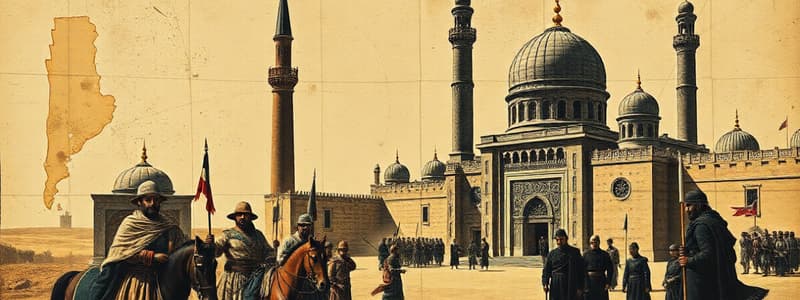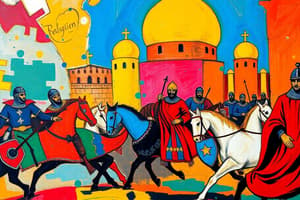Podcast
Questions and Answers
What was the primary reason Saladin was able to rise to power and unite Egypt and Syria?
What was the primary reason Saladin was able to rise to power and unite Egypt and Syria?
- He received direct military and financial support from European powers, who saw him as a potential ally against other Muslim factions.
- The existing powers, such as the Seljuks and Fatimids, were preoccupied with internal conflicts and maintaining a balance of power, creating a power vacuum. (correct)
- He was the chosen successor of the Abbasid Caliphate, granting him legitimacy and authority.
- He forged a strong alliance with the Assassins, using their network and skills to overthrow rival rulers.
Why was Saladin's capture of Jerusalem considered a significant event, even among non-Crusader populations in the Middle East?
Why was Saladin's capture of Jerusalem considered a significant event, even among non-Crusader populations in the Middle East?
- He destroyed all Christian and Jewish religious sites, establishing Islam as the sole religion in the city.
- He ensured the safety of all inhabitants, including Crusaders, and allowed them to leave peacefully, earning him respect for his virtue and honor. (correct)
- He forced all residents to convert to Islam, unifying the city under a single religious authority and ending sectarian violence.
- He implemented a fair system of taxation that benefited all residents, regardless of their religious affiliation.
What crucial tactical advantage did Saladin's forces exploit at the Battle of Hattin to defeat the Crusaders?
What crucial tactical advantage did Saladin's forces exploit at the Battle of Hattin to defeat the Crusaders?
- Utilizing advanced siege weaponry to break through the Crusader defenses.
- Employing a scorched earth policy to deprive the Crusaders of resources and reinforcements.
- Cutting off the Crusader army's access to water in the arid environment, leading to their dehydration and weakening. (correct)
- Launching a surprise naval assault on the Crusader supply lines, disrupting their logistical support.
How did the internal dynamics and relationships between the Seljuks, Fatimids, and Assassins contribute to the political landscape before Saladin's rise?
How did the internal dynamics and relationships between the Seljuks, Fatimids, and Assassins contribute to the political landscape before Saladin's rise?
In what way did the Third Crusade, led by European monarchs, ultimately contribute to the long-term geopolitical situation in the Middle East?
In what way did the Third Crusade, led by European monarchs, ultimately contribute to the long-term geopolitical situation in the Middle East?
Upon their initial encounters in 1096, how were the Crusaders primarily perceived by the Muslims in the Middle East?
Upon their initial encounters in 1096, how were the Crusaders primarily perceived by the Muslims in the Middle East?
Which of the following cultural differences contributed most significantly to the initial negative perception of the Crusaders by the Muslims?
Which of the following cultural differences contributed most significantly to the initial negative perception of the Crusaders by the Muslims?
Why did Muslims broadly categorize all Crusaders as 'Franks' (Franji)?
Why did Muslims broadly categorize all Crusaders as 'Franks' (Franji)?
What event in 1099 dramatically shifted Muslim sentiment from disinterest to outrage regarding the Crusader presence in the Middle East?
What event in 1099 dramatically shifted Muslim sentiment from disinterest to outrage regarding the Crusader presence in the Middle East?
Following the massacre in Jerusalem in 1099, why was the Muslim world unable to mount an immediate and unified military response against the Crusaders?
Following the massacre in Jerusalem in 1099, why was the Muslim world unable to mount an immediate and unified military response against the Crusaders?
Flashcards
Abbasid Caliphate
Abbasid Caliphate
The technical rulers of the Islamic world, weakened by regional conflicts.
Saladin
Saladin
An officer who established the Ayyubid dynasty and defeated the Crusaders.
Ayyubid Dynasty
Ayyubid Dynasty
Saladin's dynasty, ruling Egypt and Syria.
Battle of Hattin
Battle of Hattin
Signup and view all the flashcards
Third Crusade
Third Crusade
Signup and view all the flashcards
Crusaders
Crusaders
Signup and view all the flashcards
Saracens
Saracens
Signup and view all the flashcards
Franji (Franks)
Franji (Franks)
Signup and view all the flashcards
Siege of Jerusalem (1099)
Siege of Jerusalem (1099)
Signup and view all the flashcards
Middle East Pre-Crusades
Middle East Pre-Crusades
Signup and view all the flashcards
Study Notes
- Initial encounters with Crusaders in 1096 left Muslims unimpressed due to their poor hygiene, heavy armor, and unfamiliar customs.
- Muslims referred to all Western Europeans as "Franji" or Franks, due to their assumption that all came from France
- The Crusaders' habits of eating pork and consuming alcohol were also frowned upon.
- Before the Crusades, the Middle East maintained relative stability with a focus on education and, to some extent, plurality.
- Initial lack of interest in the Crusades until the siege of Jerusalem in 1099.
Outrage and Inability to Respond
- The Crusader siege of Jerusalem in 1099 and subsequent massacre of over 20,000 civilians sparked outrage among Muslims.
- Internal divisions and rivalries among Islamic powers, such as the Abbasid Caliphate, Seljuks, Fatimids, and Assassins, hindered a unified response.
- No existing power was in a position to effectively counter the Crusader threat due to internal conflicts.
Saladin's Rise
- Saladin, an officer in Nur al-Din's army, emerged as a leader capable of challenging the Crusaders.
- Saladin conquered Fatimid Egypt and established the Ayyubid dynasty, independent of his overlords.
- He consolidated power over both Egypt and Syria, carefully avoiding conflict with the Assassins.
- He was determined to expel the Crusaders from the region.
Victory and Legacy
- Saladin's forces gained a decisive victory at the Battle of Hattin by controlling access to water and weakening the Crusader army through dehydration.
- Saladin recaptured Jerusalem, promising safety to all inhabitants, including Crusaders.
- Saladin's virtuous conduct earned him respect among Orthodox Christians and Jews in the Middle East.
- Dante Alighieri included Saladin in the Temple of Wisdom in his Inferno, recognizing his noble character.
Later Crusades
- Subsequent Crusades, including the Third Crusade led by Richard the Lionheart, were largely unsuccessful.
- Internal conflicts and setbacks, such as the death of Barbarossa, hampered Crusader efforts.
- Middle Eastern states remained fragmented, avoiding a return to the previous stalemate.
Studying That Suits You
Use AI to generate personalized quizzes and flashcards to suit your learning preferences.
Description
Initial Muslim encounters with Crusaders were unfavorable due to cultural differences. The siege of Jerusalem in 1099 sparked outrage. Internal divisions hindered a unified response until Saladin's rise.




